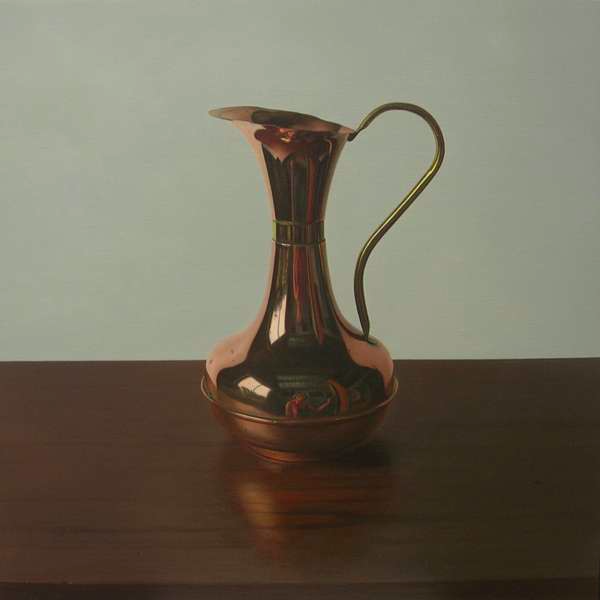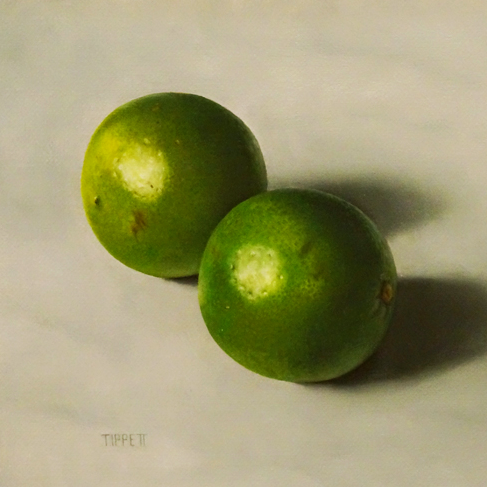Copper Jug, Pam Tippett (2008)
Looking at Pam’s art one might assume it’s a photo, they appear to be so realistic that a viewer may feel deceived by their eyes, squinting to see the brushstrokes or any other tell tale sign that will betray the artwork as a painting. Pam is passionate and rambling – in the best kind of way – expressive and eager to share her stories and opinions. Pam’s artworks portray that she is a perfectionist and furthermore that she is able to successfully fulfil that perfectionism, a rare talent. Still life painting draws us to the beauty of the ordinary, identifying the life that inanimate objects possess.
Pamela Anne Tippet is an Australia artist who was born in Lismore in 1950. She never took art during high school because it clashed with other subjects and growing up – although she enjoyed art – she never realised it’s what she would end up doing. In 1972 she graduated with a Bachelor of Science from the University of Sydney and as result began teaching Science, yet she now works and lives as an artist in the Southern Highlands.
Pam’s fascination with science was something she acquired growing up and throughout her studies, “I was following a science background, so I went off to uni and did a science degree and then I taught for a couple of years in Papa New Guinea and then I had saved a lot of money so I went over to Europe and that’s when I started studying art.” Whilst studying zoology and biology Pam said she was always told she was brilliant at drawing detailed diagrams of specimens, often being told “You should do that for a living!” Now she maintains a keen interest in Science, intrigued by new discoveries and endeavors that scientists make. Although, she has upheld her interest in science and enjoyed teaching, she had earned enough money by the time the opportunity was presented to study in Europe so she thought, “I’m not going to be a scientist, clearly! So I might as well try to be an artist.” It seems bizarre to switch from two careers which seem like exact opposites but Pam seems to be someone who is not only both academic and creative, but successful at both.
Pam formally studied art in Florence under the guidance of Nerina Simi. Nerina Simi was the daughter and student of the distinguished artist, Filadelfo Simi, but when he passed she continued his work and teaching at the studio he had owned in Florence. Pam spoke with fondness of the meticulous work she undertook at Signorina Simi’s studio. By the time Pam had been offered the opportunity to study in Florence, Nerina Simi was already in her late 80’s, and although she may have been weathered she was no less tough. She could be a harsh teacher, sometimes pushing her students to tears or scribbling all over a portrait they’d worked on for weeks when they didn’t correct their imperfections. She encouraged them to excel at the art practices and processes by making sure they had perfected every aspect of portraiture, figures and still life art. During her time studying in Florence Pam was occasionally fearful of how Nerina Simi might critique her. Now, Pam laughs at the memory as the rest of the class would sit in horror as one student’s work would be torn apart by Signorina Simi, and although she felt sorry for the one individual she’d be thinking along with the students who had been spared, “Oh gosh, thank goodness it wasn’t us!”
Although students would usually study with Signorina Simi for 10 years, Simi passing away during her mid 90’s cut the apprenticeship short. Pam often describes Simi as a harsh teacher admitting that, “she could be very cruel sometimes.” However, she was constantly inspired by her audacity and teaching, saying with a smile that, “She was very witty with her comments most of the time.” Pam reminisces of the lessons she’s been taught which have enabled her to achieve the career she has today, and is thankful for the control and precision it has taught her. And although she had a teacher who showed little mercy, she believes it to have been a necessary part of her training in the career she has established today.
Nerina focused intensely on students when they first began, breaking them down to discover what they did wrong until they learnt to correct their mistakes. Towards the end of her apprenticeship at Studio Simi Pam noticed that Nerina would leave her to her own devices. Admittedly, Pam said Signorita Simi had picked on her a few times and after one particularly brutal critique when she was almost reduced to tears she felt she had overcome a hurdle with the teacher. Pam speaks fondly even of the more worse moments of her study, she believed Nerina thought that, “Australian’s have a got a fairly sort of take-it-or-leave-it attitude and I think that she thought that I wasn’t serious enough… The fact that she nearly reduced me to tears made me look like I was more serious.” During her time in Florence she focused on portraits, figures and still life, learning to adapt to perfect the techniques needed for art that is such a slow and grueling process.
Because Pam now focuses on still life’s – which are realistic paintings of inanimate objects – she has a variety of endless things to paint, the only task is choosing what to paint. Although some objects she paints may appear useless they usually have some personal connection to her, something she’s collected, a reminder, something she’d owned for a long time. Other than that the textures, colours, contrast, shapes and shadows of something as simple as a lime inspire her, finding beauty in simple things.
Limes, Pam Tippett (2012)
Some of her artworks recognise Pam’s acute interest in objects with reflections, as its more challenging to capture such details. Asides from still life art Pam also does a lot of portraitures, something which she originally specialised in. Although portraitures are what she enjoyed doing most Pam had made a connection with a gallery who successfully sold her still life paintings, so that’s what was demanded of her. “It’s not too much of a compromise because I sort of try to find subject matter that either I haven’t done before or sometimes I’ll do something that I’ve done a lot of because it’s easier, because I know all the problems but often I’ll choose a subject that I haven’t painted before.” However, in 2004 and again in 2011 one of her self-portraits was nominated for an Archibald prize. Although she didn’t win the prize she felt as though being nominated for such a major prize was a victory within itself. While Pam’s art studies had focused on portraiture she acknowledges that when it comes to earning a living, “Portraitures are really hard because you’ve got to either have a big gimmick or know famous people or something. Whereas still life painting it’s just you and your little object.” Pam had always been good at capturing the essence of a person and finding alikeness in a portrait. When it comes to still life she has to find things which interest and challenge her otherwise she can get bored because still life painting is a long process.
Self-portrait (for a change), Pam Tippett (2011)
Pam is a humble person, saying that she’s not particularly proud of one single exhibition, after a while they tend to blur together and displaying your work is all part of the job. When she first began trying to make her name heard in the Australian art industry Pam would periodically take up slides of her work to Sydney in the hope of making a gallery connection only to repeatedly be rejected, “It was one of the most demoralising things that you can do.” Art isn’t always the most generous career and becoming globally recognised is almost impossible, today the artists most heard of are those that died a long time ago. There were times when Pam’s art had to take a backseat to other jobs that would ensure she could earn some kind of living. Nowadays, Pam has a connection with a Sydney art gallery as well as some regional galleries that constantly commission her still-life paintings.
Pam describes different art prizes as being “near misses”. She thinks back on one of her mentors telling her that you can’t lose them all, with a humorous laugh she says, “But it’s not true, you can lose them all!” There’s no doubt the art world is hard, especially when you need secure income and there are periods where Pam – and struggling artists alike – apply for things or put strenuous amounts of work into an exhibition or showcase piece only to be turned down or have unsuccessful results. It’s a job which requires resilience despite the constant disappointments. Pam is interested in trying different art forms but she feels that although, “there’d be a lot of things I’d be interested in doing but I don’t have the time, truly, that’s what it falls down to. Otherwise my energy is just to scattered.”
Pam’s artworks are unique in their precision and beauty, as Angela D’Elia, curator of Pam’s exhibition at Goulburn Regional Art Gallery, proclaimed, “It could be an everyday object, portrayed just as she saw it and reflecting that ‘something special’ element which attracted her to it in the first place. Her works have a spark of life which take them beyond being just studies in technical brilliance.”




